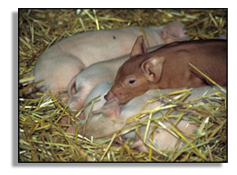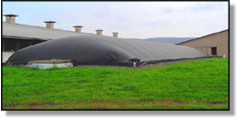Energy Use on Farms and Ranches
Energy is one of the more expensive components of raising crops and livestock. In fact, United States Department of Agriculture economists found in 2005 that energy costs, on average, account for just under 15 percent of the agricultural communities total expenses.
In this issue, the Quarterly looks at ways to make farm animal buildings more efficient, and presents information on energy savings from anaerobic digestion systems.
Keeping ‘Em Warm and More!
Energy Efficiency in Animal Housing
In November 2006, the U.S. Department of Agriculture announced the release of the “Energy Estimator for Animal Housing,” the fourth web-based energy awareness tool the federal agency has developed as part of their overall energy strategy.
 Designed to help agricultural producers reduce energy costs related to animal housing, the tool evaluates the energy use and costs associated with heating, lighting and ventilating poultry, swine and dairy housing.
Designed to help agricultural producers reduce energy costs related to animal housing, the tool evaluates the energy use and costs associated with heating, lighting and ventilating poultry, swine and dairy housing.Producers with animal feeding operations can save up to $250 million annually nationwide by regularly maintaining their ventilation and heating systems and using more energy-efficient fixtures and equipment. An individual producer may realize up to 50 percent savings in energy use by maintaining their ventilation and heating equipment regularly.
The web-based “Energy Estimator for Animal Housing” has three components — poultry, swine and dairy — that operate independently. The swine component allows the producer to evaluate heating, lighting and ventilation for three production stages: farrowing (birth to about 15 pounds), nursery (weaning) and finishing (growing) as well as for the overall animal housing. The user can select one or more swine production stages for analysis. For poultry, the producer provides ventilation, lighting and heating information for the entire broiler house. The dairy component also evaluates lighting as well as milk pumping and cooling options.
 Once the required information has been entered, the software provides an analysis of estimated energy use and costs associated with various energy management options. The analysis also identifies potential energy savings that can result from carrying out certain recommendations.
Once the required information has been entered, the software provides an analysis of estimated energy use and costs associated with various energy management options. The analysis also identifies potential energy savings that can result from carrying out certain recommendations.
Producers should use the “Energy Estimator for Animal Housing” for guidance rather than as a sole source for decision-making on energy matters related to animal housing. This tool evaluates alternatives based on producer input, but does not offer site-specific recommendations. It also does not estimate the cost of implementing recommended practices. It is recommended that producers take their animal housing energy analysis to their local USDA Service Center, Cooperative Extension office or Rural Electric Cooperative for more field-specific assistance.
Is It Right for Your Operations?
Anaerobic Digestion for Dairies and Feedlots
In February 2005, the Northwest Combined Heat and Power Application Center published a fact sheet on “Combined Heat and Power Biopower/Anaerobic Digestion: Have you asked all the right questions?” that is now available online at the Center’s web site.

Written by Dave Sjoding, Washington State University Energy Program, the fact sheet covers topics including: types of digester technology, digester experience of project developer, economics and financing, co-product revenues, management and operations, power equipment, energy production, permits, utility sales and interconnection and technology specific questions including thermophilic processes and plug flow digesters.